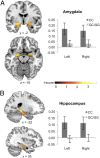PACAP receptor gene polymorphism impacts fear responses in the amygdala and hippocampus
- PMID: 24516127
- PMCID: PMC3939867
- DOI: 10.1073/pnas.1318954111
PACAP receptor gene polymorphism impacts fear responses in the amygdala and hippocampus
Abstract
We have recently found higher circulating levels of pituitary adenylate cyclase-activating polypeptide (PACAP) associated with posttraumatic stress disorder (PTSD) symptoms in a highly traumatized cohort of women but not men. Furthermore, a single nucleotide polymorphism in the PACAP receptor gene ADCYAP1R1, adenylate cyclase activating polypeptide 1 receptor type 1, was associated with individual differences in PTSD symptoms and psychophysiological markers of fear and anxiety. The current study outlines an investigation of individual differences in brain function associated with ADCYAP1R1 genotype. Forty-nine women who had experienced moderate to high levels of lifetime trauma participated in a functional MRI task involving passive viewing of threatening and neutral face stimuli. Analyses focused on the amygdala and hippocampus, regions that play central roles in the pathophysiology of PTSD and are known to have high densities of PACAP receptors. The risk genotype was associated with increased reactivity of the amygdala and hippocampus to threat stimuli and decreased functional connectivity between the amygdala and hippocampus. The findings indicate that the PACAP system modulates medial temporal lobe function in humans. Individual differences in ADCYAP1R1 genotype may contribute to dysregulated fear circuitry known to play a central role in PTSD and other anxiety disorders.
Keywords: emotion; fMRI; intermediate phenotype; single nucleotide polymorphism.
Conflict of interest statement
The authors declare no conflict of interest.
Figures


References
-
- Kessler RC, et al. Lifetime prevalence and age-of-onset distributions of DSM-IV disorders in the National Comorbidity Survey Replication. Arch Gen Psychiatry. 2005;62(6):593–602. - PubMed
-
- Pacella ML, Hruska B, Delahanty DL. The physical health consequences of PTSD and PTSD symptoms: A meta-analytic review. J Anxiety Disord. 2013;27(1):33–46. - PubMed
-
- True WR, et al. A twin study of genetic and environmental contributions to liability for posttraumatic stress symptoms. Arch Gen Psychiatry. 1993;50(4):257–264. - PubMed
Publication types
MeSH terms
Substances
Grants and funding
- M01RR00039/RR/NCRR NIH HHS/United States
- R56 MH071537/MH/NIMH NIH HHS/United States
- UL1TR000454/TR/NCATS NIH HHS/United States
- R01 MH071537/MH/NIMH NIH HHS/United States
- P51 OD011132/OD/NIH HHS/United States
- HHMI/Howard Hughes Medical Institute/United States
- MH096764/MH/NIMH NIH HHS/United States
- M01 RR000039/RR/NCRR NIH HHS/United States
- R01 MH096764/MH/NIMH NIH HHS/United States
- F32 MH101976/MH/NIMH NIH HHS/United States
- UL1 TR000454/TR/NCATS NIH HHS/United States
- MH071537/MH/NIMH NIH HHS/United States
LinkOut - more resources
Full Text Sources
Other Literature Sources
Medical

